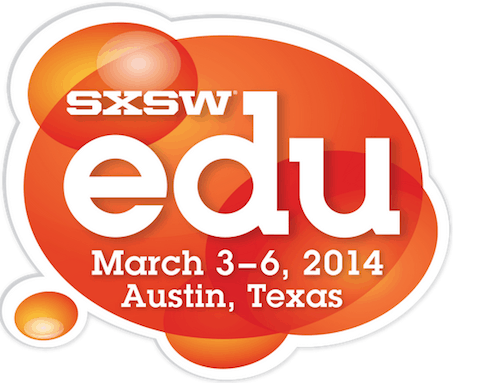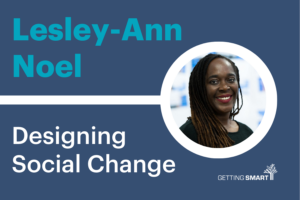SXSWedu: That’s a Wrap!

Day four has come and gone but fortunately there were great sessions to wrap up a wonderful 2014 SXSWedu. As we all make our way back home and reflect on the lessons learned, hopefully everyone is ready to go out and make change- whether it be in the classroom or the community. We’re sad to see SXSWedu come to an end but we hope you enjoyed our recaps over the last few days, here’s to a new year of innovations in learning!
P.S. We’ll soon be posting our list of interesting edupreneurs, start-ups, youth and much more so keep an eye out!
Learning and the Internet. Panelists John Bailey, Rosario Dawson, Anil Dash and Charlie Firestone touched on the importance of digital literacy and the opportunity and importance of teaching students digital safety. The mission of the Aspen Task Force is to “build an online environment that is safe and optimized for learning.” The task force is working to ensure:
- That online locations are safe and respect privacy;
- Provide access for all;
- Sufficient tools to take advantage of the opportunities; and
- Create an infrastructure for learning, inside and outside of the classroom.
The task force is taking a non-partisan approach to address learning and the internet and understand that building this online environment goes all the way to impacting policy. Throughout their mission the task force has learned that:
- Learning networks matter;
- Learning that is active, engaged and personalized made possible by “learning infrastructures” that unify educational resources and put the learner at the center; and
- Young learners should be supported in creating and/or utilizing these networks with minimal barriers. It should be safe and rewarding. And should allow young learners to create, edit and remix content.
There was a cohesive opinion with all panelists that it’s time to change the system and take advantage of the new ecosystem we have. Bailey said it well, “we have an institutional based model asking students to conform to the institution instead of the institution conforming to the student” Bailey also discussed creating a “Siri GPS for student experiences” to help students find the places, resources, and networks to help take them where they want to be. “Technology doesn’t replace teachers- it creates a new role for them, a more important role” added Bailey.
E-Rate 2.0 – Reboot, Reinvigorate and Recharge. Jessica Rosenworcel traveled from Washington DC to share how the Federal Communications Commission (FCC) is working to improve educational opportunities for students with the E-Rate, the nation’s largest technology program- although it is not well known, it has already done a lot of good. Today, it is taking on the challenge of building capacity for schools. Too many schools can’t offer essential 21st century learning tools now available that allow students to succeed at the highest level- particularly in the STEM fields.
We are now a nation with more mobile phones than people and rely on taking the content we consume with us wherever we go. Three quarters of all kids now have access to a mobile device. 72% of children under age 8 have used them for media activity. 1 in 5 do so in a daily basis. 9 in 10 teenagers today use social media and 95% use the internet regularly “We kid ourselves if we think all of this change is going to stop at the school door. If we’re smart we’ll let it in and wrestle with its full potential” added Rosenworcel.
The 3 S’s of E-Rate 2.0:
-
Speed. High speed, high capacity broadband – but 85% of schools don’t feel they have the bandwidth they need to run technology for students effectively. Adopting high goals that for making bandwidth available for schools nationwide will encourage growth in education and in community.
-
Simplify. This process should be about blazing the path for the digital age but why is it so lengthy and require such a paper trail? If applications were only due every other year administrative costs would be cut in half. Simplicity should include greater transparency in the e-rate process, which applicants often complain is too opaque.
-
Spend Smart. E-rate needs to phase down the expense on outdated services and build up the purchasing power for the programs that make sense for students today. We need to bring back the purchasing power that inflation taken away from this program. The rest of the world is on this path and we can’t be left behind.
Take Flight. Anita Verna Crofts of the University of Washington’s Department of Communication focuses on one core tenant for her courses; let students lead. As the “Flight Instructor”, Crofts and her “Flight Crew” of talented professionals are attempting to transform how students experience higher education. Crofts teaches at the Communication Leadership program at University of Washington. The program focuses on building strong community in the classroom. Crofts highlights that her goal when creating a class is to make it feel more like a dinner party that you don’t want to leave. Can you imagine a higher education course like that? This communication course, that meets 9am-5pm on Saturdays throughout the semester, curates a shared playlist as just one of the many best practices for creating a community with all students. Chefs and community based organizations bring the Seattle community into the classroom through food throughout the semester as well. “When you let students lead they will blow your mind again and again,” said Crofts.
When Does EdTech Just Become Education? As SXSWedu begins to wind down Idit Harel Caperton (@Globaloria), Tony Wan (@edsurge) and Jaime Casap (@jcasap, @googleforedu) formed a panel to highlight what is next for EdTech. Right now, school environments are not innovative at the core and great education can only be fostered in silos which really needs to change. Learning models need to change but are we up for the challenge?
The idea that there is an seperation between technology and education is false- learning is either happening or it is not. Casap defined the problem as the world has shifted beneath our feet but the school policies have not yet shifted. Unfortunately, that can lead to digital technology just taking bad education and making faster and more efficient. Today’s kids are not different than who we are – they just learn in a different way and they will do that with or without school buy in. In order for schools to transform, we need to hear more student voice in this conversation because right now technology is being done to the students or “on behalf” of students – and the adult vision doesn’t necessarily match up to student practice.
Technology is not the silver bullet, but how can we use these tools to teach our kids about the skills they really want to build like collaboration, critical thinking, problem solving – all to support lifelong learning. Wan recognizes that edtech will never replace the human element of teaching and learning. Implementing technology classroom raises many questions about best practice, but sharing the experiences and stories of what is developing and how it is being used is key for seamlessly merging technology into education. It’s time to get technology out of the way so we can let learning happen.
Clap (and Laugh) if You’ve Learned Something Here at #SXSWedu. Actor (and comedian) Jeffrey Tambor keynoted and officially wrapped our 4 great days in Austin. Not only is Tambor an actor, but a teacher of acting and a dedicated father. He shared the emotional and heartwarming story of his son’s first lacrosse game, where he overcame so many obstacles to truly succeed. This feeling of success which can also be known as the “Atta Boy” feeling – or confidence you get from knowing what you are doing and being good at it changed his son’s experience even the next day after the game had ended. Tambor didn’t have an easy time growing up either but he remembers the experiences and more importantly the teachers in his life that has built his confidence and helped be the multi-talented person he is today.
At a conference that truly brings together a very mixed audience of EdTech stakeholders, the closing keynote message from Tambor was perfect for all and was well received with a lot of laughter involved. No matter what part of education you touch, we are all here for one real reason- the kids. We are all here to build confidence and make our next generation great.
Digital Learning Now! is a Getting Smart Advocacy Partner.





0 Comments
Leave a Comment
Your email address will not be published. All fields are required.